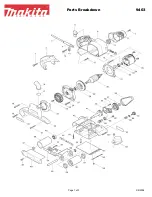
4
prematurely. Instead, install them on a short length of air hose attached to the tool.
13. Check for damaged parts. Before using any tool, any part that appears damaged
should be carefully checked to determine that it will operate properly and perform its
intended function. Check for alignment and binding of moving parts; any broken parts
or mounting fixtures; and any other condition that may affect proper operation. Any
part that is damaged should be properly repaired or replaced by a qualified technician.
14. Maintenance. For your safety, maintenance should be performed regularly by a
qualified technician using original CANNONTOOLS replacement parts.
Failure to do so can lead to accidents for the operator. Use of any other parts will void
the warranty. Only use accessories intended for use with this tool. Use only accessories that
are recommended by the manufacturer for your model. Accessories that may be suitable
for one tool may become hazardous when used on another tool.
WARNING:
Repetitive motions or exposure to vibration may be harmful to your hands and arms.
WARNING:
The warnings, cautions, and instructions discussed in this instruction manual cannot cover all possible
conditions and situations that may occur. It must be understood by the operator that common sense and caution
are factors which cannot be built into this product, but must be supplied by the operator.
ASSEMBLY / INSTALLATION
1. You will need to prepare the 1/4" Quick-disconnect Coupler Plug to connect to the air
inlet on the sander. Wrap the Coupler Plug with pipe thread seal tape before threading it
into the Air Inlet. Connect the a Quick-Disconnect coupler on a 3/8" ID Air Source Hose
to the tool.
Note: If you are not using an automatic oiler system, before operation, add a few drops of
Pneumatic Tool Oil to the airline connection. Add a few drops more after each hour of
continual use.
2. Set the air pressure on your compressor to 6 bar. Do not exceed the recommended air
pressure of 6 bar.
3. Check the air connection for leaks. Once you are satisfied there are no leaks, turn off the
air compressor and disconnect the tool.
AIR SOURCE
Clean air of correct air pressure is recommended for the power supply for this tool. A
maximum of 6 bar at the tool is recommended for most air tools of this class. Check
specifications section for recommended pressure. (Depending on length of air hose and
other circumstances, air pressure at compressor may need to be increased to 100 PSI to
ensure 90 PSI at the tool.)
Water in the air hose and compressor tank contributes to reduced performance and
damage of the air tool. Drain the air tank and filters before each use and as necessary to
keep the air supply dry.
Hose length over 25’ causes loss in line pressure. Increase hose I.D. or increase
compressor pressure to compensate for the pressure loss. Use an in-line pressure
regulator with gauge if air inlet pressure is critical.


























